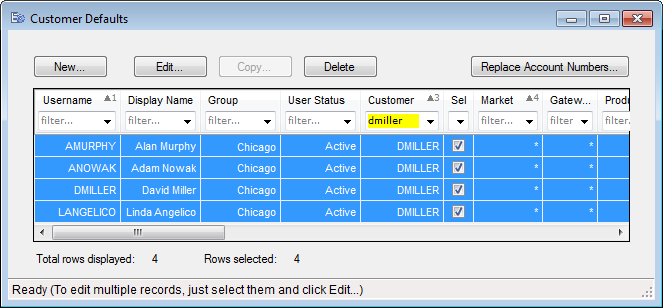

- USER DEFAULTS SWIFT 3 UPDATE UPDATE
- USER DEFAULTS SWIFT 3 UPDATE ARCHIVE
- USER DEFAULTS SWIFT 3 UPDATE CODE
Let’s go back to the kitchen and sprinkle some syntax. Swift 3.x & 4.x For getting all keys & values:įor (key, value) in made this generic class which helps me reading values from user defaults. use UIKit at some stage in their applications to bring intuitive user interfaces to their apps. Swift is an insanely great language and we should be challenging a lot of what we’ve learnt and know from our days writing Objective-C. But when I try to pull the value back from UserDefaults, its 0.0. The problem I have is the following : User can write a note (saved in UserDefaults) and open Notification Center and watch his notes in a TodayExtension. Problem just appears in Swift 2.3 and Swift 3, on iOS 10. I have had no problem in Swift 2.2 and iOS 9. I have gone through and printed each variable individually to make sure they all have data and all the way to latestBottle everything is fine. Im working on an easy note application with today extension. Now I test different languages by setting Scheme > Application Language > language. I tried to set it like this: let defaults NSUserDefaults.standardUserDefaults () tObject ('de', forKey: 'AppleLanguages') And after app restart language is still system default. I have saved the users favorite Locations in the (forKey: 'heart') The heart button on the SpotDetailView saves the spot and also displays whether it is a favorite or not. I am trying to implement a function that can change app language.
USER DEFAULTS SWIFT 3 UPDATE CODE
users/your user name/Library/Application Support/iPhone Simulator//Applications You can print all current NSUserDefaults to the dictionaryRepresentation] dictionaryRepresentation]) Totally stumped on why the below code isnt saving correctly. I am Working on an App in XCode that Displays Locations saved on a JSON file from an URL. Use this to get the location of your apps directory: print(NSHomeDirectory()) from that location, go to Library>Preferences> this will be where NSUserDefaults is saving your data. Is there a way to see what’s been saved to NSUserDefaults directly?
USER DEFAULTS SWIFT 3 UPDATE ARCHIVE
If you want to store any other type of object, you should typically archive it to create an instance of NSData. For example, you can allow users to specify their preferred units of measurement or media playback speed.

The defaults system allows an app to customize its behavior to match a user’s preferences. Let data = defaults.objectForKey("YOUR_KEY_NAME")Ī default object must be a property list-that is, an instance of (or for collections, a combination of instances of) NSData, NSString, NSNumber, NSDate, NSArray, or NSDictionary. The UserDefaults class provides a programmatic interface for interacting with the defaults system. You can use UserDefaults to store any basic data type for as long as the app is installed. NSString* strValue = [defaults = strValue != nil ? strValue : Value" Reading and writing basics: UserDefaults. You use it to save your app user’s settings, set some flags, or simply use it as a tiny data store. The UserDefaults object, formerly known as NSUserDefaults, is exceptionally useful for storing small pieces of data in your app. The second print statement confirms that the reset () method. By Aasif Khan Last Updated on April 6th, 2023 4:07 pm 5-min read.

We then invoke the reset () method to clear the user's defaults database. The first print statement confirms that this works. We use the Keys enum to set the value of the allowDownloadsOverCellular key to true. Swift let defaults = UserDefaults.standardĭt(YOUR_VALUE, forKey: "YOUR_KEY_NAME") Run the contents of the playground and inspect the output in the console. These methods are described in Setting Default Values. The NSUserDefaults class provides convenience methods for accessing common types such as floats, doubles, integers, Boolean values, and URLs.
USER DEFAULTS SWIFT 3 UPDATE UPDATE
The NSUserDefaults class provides a programmatic interface for interacting with the defaults system. If your app or plugins include Objective-C or Swift code that makes use of APIs newer than iOS 11, update this setting to the. This is the built-in instance of UserDefaults that is attached to our app, but in more advanced apps you can create your own instances. NSUserDefaults : An interface to the user’s defaults database, where you store key-value pairs persistently across launches of your app.ĭeclaration : NSUserDefaults : NSObject where is nsuserdefaults stored ? So, add this after the tapCount + 1 line: (self.tapCount, forKey: 'Tap') In just that single line of code you can see three things in action: We need to use UserDefaults.standard. The easiest way to save data in IOS is using NSUserDefaults and also you ca see the data what you saved. One question arises in every IOS programmer, That whats the easy way to save some value without using any Database.Second questions is arise can i see the data i saved.


 0 kommentar(er)
0 kommentar(er)
